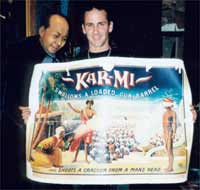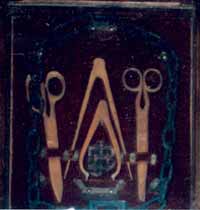|
I stand outside the Freakatorium with my face
pressed against the glass, something that many
Lower East Side residents and passer-by have probably
done. With an intriguing name and an amazing collection
of oddities, human and otherwise, even when closed
and only marginally illuminated, it's mesmerizing.
It's in this Peeping Tom position that I'm discovered
by Johnny Fox, the proprietor. He saunters towards
me in a newly-acquired leather studded cape that
he later describes as "Liberace meets Evil
Kenieval".
It's no surprise that this man would appoint
himself the historian for dime museum and side
show history. He has lived the story of the human
oddity as well as preserved it. With an ability
to swallow sixteen swords at once (a world record
if not a Guinness Book's; they closed the category
after the previous record holder slid down a mere
thirteen), and a long run living in a school bus
while travelling from street fair to street fair,
Johnny Fox has settled in close to the Bowery
and made the region's peculiar history his own.
Johnny throws his cape over a wax figure of Mao
Tse-Tung and lights a cigarette. It isn't long
before another pedestrian comes by, holding a
two-year-old child up to look through the glass.
She raps on the window even though the door is
locked. Johnny lets them inside briefly, giving
the little girl a finger puppet to entertain herself.
You'd think that the fascination with this atmosphere
belongs in childhood: the sideshow, the circus,
the sleight of hand magician who pulls a coin
out from behind your ear and startles you into
crying. It takes a special perseverance to take
that fascination through adulthood and adopt the
lifestyle as your own. Johnny found something
lacking from all comic books he read as a kid,
and started looking for around him for living
breathing heroes to emulate. "I thought,
'I want a real superhero,' and my dad bought me
a Houdini book and said, 'Here's a real superhero,
no jail cell could hold him.' And I read the book
and thought, 'Yeah it's cool, but he's dead. I
want a real superhero, who's alive.'"
 But
beyond the obvious influences you find dotting
the walls of the Freakatorium, he also credits
storytellers like Spalding Gray, Garrison Keillor,
and Eric Bogosian for shaping his life. And his
love of history and storytelling is evident as
he continues on about the history of dime museums
and his own personal history, either gnawing on
the edges of his fingernails or blowing smoke
rings towards me, which dissipate around my fingers
as I try to penetrate them. But
beyond the obvious influences you find dotting
the walls of the Freakatorium, he also credits
storytellers like Spalding Gray, Garrison Keillor,
and Eric Bogosian for shaping his life. And his
love of history and storytelling is evident as
he continues on about the history of dime museums
and his own personal history, either gnawing on
the edges of his fingernails or blowing smoke
rings towards me, which dissipate around my fingers
as I try to penetrate them.
Though he spent close to twenty years in Colorado,
Johnny Fox grew up closer to the influences of
the Bowery in Hartford, Connecticut, and even
learned many of his magician's skills from Slidini,
a local performer known as the godfather of closeup
magic. He would stay up until three or four in
the morning practicing these tricks. But the calling
of sword swallowing followed soon after. "I
was doing the magic act in Aspen. And one of the
ways we'd get people into the restaurant was to
go out and perform and gather a crowd, and say,
'Hey, you guys wanna see the good stuff follow
me back into the restaurant.' And I started getting
more interested in street performing, and thought
I could see the world this way."
He hasn't retired his act while maintaining the
Freakatorium. He still keeps a vigorous touring
schedule, as well as donating his talents for
worthy causes. "I do a show every year for
kids. Every state has a burn camp for kids that
are severely burned and burn survivors. And once
a year the fire fighter's union, the AIFF, they
do a national burn camp in western DC, and they
bring in one kid from each camp around the country
and provinces of Canada. It's happened six times,
and I've done every one of them. As a kid, I had
this thing about never growing up seeing sideshows
and superheroes, you know, that thing. Anyone
who's got the courage and bravery to stand up
in front of anybody and say, 'This is me, this
is how I am, and I'm comfortable with that.' "
The Freakatorium itself is a tribute to that
spirit. The current site located on Orchard Street
is a prototype he wants to relocate to the Bowery,
the original home of the dime museums, where human
oddities exhibited themselves before there were
sideshows.  Johnny
points out one of his favorite acquisitions –
the wood pieces carved by The Armless Wonder,
Charles Tripp, with his feet. And as I look around
the shop, at the poster for the Fiji Mermaid,
at the two-headed troll dolls, I sympathize with
these people eternally consigned to the status
of 'Freak!'. Scenes from The Elephant Man where
the unwanted and abused are exploited or starved
for affection flash through my head. Johnny
points out one of his favorite acquisitions –
the wood pieces carved by The Armless Wonder,
Charles Tripp, with his feet. And as I look around
the shop, at the poster for the Fiji Mermaid,
at the two-headed troll dolls, I sympathize with
these people eternally consigned to the status
of 'Freak!'. Scenes from The Elephant Man where
the unwanted and abused are exploited or starved
for affection flash through my head.
Johnny disagrees with that portrayal. "There
were some people who seemed like they were
being exploited. For JoJo there was a concocted
story, they would say he was captured by trappers
in Siberia he doesn't speak much, he just grunts
and growls a little bit. In reality, he was fluent
in five languages. He was not being exploited.
It might have appeared that, but sideshow performers
were making a fortune. There were also pinheads,
microcephalics. Mentally retarded. Whoever was
their manager was taking care of them; they were
making them good money. There was no way they
were going to mistreat them or abuse them. They
wanted them to be healthy, they wanted them to
be happy. They taught them simple little magic
tricks and they were entertaining people. And
people were laughing at them, and they would introduce
them saying they were Aztecs, a lost tribe. So
after sideshows stopped doing that, what happened
to these microcephalic pinheads? They went into
institutions. And I believe they were much happier
entertaining people. So is it exploiting if someone
is happier?"
He does concede that some sideshow performers
were mistreated. "Sometimes it was unfair.
The managers were taking the lion's share. Like
in the case of the Siamese twins Daisy and Violet
Hilton." But when it comes down to it, some
people choose this sideshow lifestyle, and will
willingly participate in it and memorialize it
like Johnny. "This is a part of New York
history that isn't being preserved that there
is so much interest for nowadays."
The interest has extended to media coverage,
including a story by ABC news and a feature by
Time Out during The Freakatorium's year-and-a-half
existence. "I think the media wants to see
it happen. I don't know why people would give
me free advertising like that except that they'd
want to see it turn into something. So they're
giving me the tools to use and see what I do with
it."
And the project is still in the making, involving
valuing and inventorying his collection, and presenting
a business plan to possible investors in the hopes
of buying a building on the Bowery. In the new
home of the Freakatorium, Johnny envisions combining
the resources of his sideshow artifacts with a
small beer and wine garden. And of course there
would be performances. "When I first started
the place the vision was to have a theater, to
do the theater shows and to have the lobby of
the theater to be a mini-museum so the show would
start as you walked into the theater. The inside
of the theater would be decorated with old sideshow
banners, and present some illusions that were
done, like Spidora, the head of a human being
and the body of a spider."
It seems like an awesome task to bring this project
together, but Johnny's years of busking and street
performance have given him a Darwinian approach
to business, and his passion for the sideshow
freak an ability to isolate that unique quality
and become its foremost expert. "I think
we're all freaks. We all have something that's
unique and unusual about us, whether it's the
way we think about things, the way we react to
things, the way we dress. There's people that
are freaks about their looks, they go and get
plastic surgery and they don't have to. You know,
there's so many different types of freaks. Some
people admit it, some people embrace it, some
people hide from it and deny it." And some
appoint themselves to keep its history alive.
This article originally ran in December 2000
in plasmotica.com.
The freakatorium is located at 57 Clinton Street
between Stanton and Rivington. For more information
visit www.freakatorium.com
Return
to Top
|
|